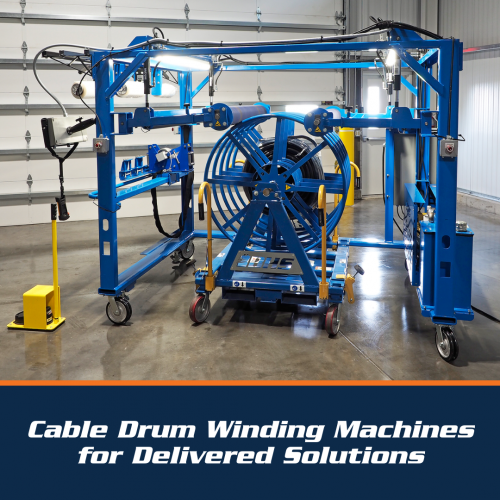We use cookies to make your experience better. To comply with the new e-Privacy directive, we need to ask for your consent to set the cookies. Learn more.
Cable Drum Winding Machines for Delivered Solutions
Traditional cable drum winding machines require a complex series of set-up actions before you can even begin filling the take-up drum. For cut-to-length wire and cable distributors, who repeat the process with every order, these additional steps add up to substantial lost productivity.
For instance, take a standard shaftless, pintle-loading cable winding machine. In order to fill an order using this device, operators must follow these steps: 
-
Retrieve the take-up cable drum from storage. If the order is large enough, this drum could weigh hundreds of pounds, requiring a forklift with a Reel Handler Attachment for safe lifting, requiring yet another step: Preparing the lift truck. And if empty drums are stored on drum jacks, employees must lower the unit to ground level and remove the shaft before proceeding.
-
Transport the drum to the cable winding machine, located in front of the master drum. Again, this often requires dedicated material handling equipment. Manual lifts or attempting to roll a take-up drum can lead to musculoskeletal disorders or even serious injury to staff.
-
Attach the take-up drum to the drum roller pintle arms. Typically, this involves attaching the appropriate pintle for the current drum-size, adjusting the cantilever arms to line up with the bore, and collapsing those arms to create a firm grasp on the take-up drum.
-
Only then can users begin to fill the order. If the coiling unit doesn’t have an integrated cable counter, it’s easy to make mistakes on the length you’re actually paying out. This can lead to waste or, worse, shorting customers on orders.
-
With the drum filled, operators must then transport it to the shipping area. This, again, involves the use of forklifts with heavy duty drum-carrying attachments.
Coil winding machines that use shafts require yet another step, as the drum must be loaded onto the specialized shaft prior to filling. And the disadvantages of this design are even more apparent in applications that offer multiple packaging options to their customers. Increasingly, wire and cable distributors must provide value-added services in order to win business away from low-priced B2B online dealers.
Delivered solutions, which bundle cable orders with drums and the payout stands to provide the customer with a complete, ready-to-deploy package, are a powerful incentive to choose one distributor over the next. Following the job, contractors can return the payout stand for use on the next order; for larger orders, distributors may even add the stands gratis.
In order to build a delivered solution with a traditional coiling machine, operators must load the filled drum onto a Parallel Reel Payout after it’s filled, creating another material handling hurdle that can add costly labor time to each order.
All of these conditions explain why BHS engineered a unique drum roller called the Parallel Reel Payout. The breakthrough in this design consists of inverting the traditional material flow between cable drums and their winding machines: Rather than take the drum to the winder, the SWT lets users bring the winder to the drum.
With this innovative approach, the SWT eliminates many of the steps traditionally associated with filling cut-to-length cable orders, particularly as part of a ready-to-pull delivered solution. Here’s how the process of filling a delivered solution order works with an SWT:
-
Operators position the SWT over the take-up drum, which sits ready on a Parallel Reel Payout or jack stand. The SWT frame is designed to roll easily into place, removing the need for additional material handling equipment for travel. Similarly, users can manually place Parallel Reel Payouts in front of master drums quickly and without ergonomic risk. Either way, users then engage the SWT’s floor brake before operating the unit.
Standard safety features keep workers clear of moving parts during operation. These include an alarm and strobe light, which both activate when roller arms are in motion; dual floor locks for stability during use; and retractable personnel barriers which block off a spooling zone between cable reel racks and the unit.
-
The SWT’s overhead rim drive is lowered to engage with drums and spools of all sizes. Users feed the cable through an integrated counter and they’re ready to fill the order — while tracking inventory and ensuring accurate order fulfillment.
-
Users fill the drums. Multiple speeds and a sliding cable locator give the operator full control over the process; once the coil is running smoothly, they can boost the speed to complete jobs as efficiently as possible. After cutting cable and plastic wrapping, available as an optional feature on the SWT, the order is complete.
All that’s left is for users to wheel the full delivered solution to a truck for delivery. By eliminating much of the pre- and post-order-fulfillment material handling — particularly moving cable drums in and out of storage — a cable drum winding machine like the SWT can speed up order fulfillment in cut-to-length cable distribution facilities, particularly in the context of a full delivered solution. To learn more about material handling equipment for cable and wire distributors, call the BHS sales team at 1.800.BHS.9500.

